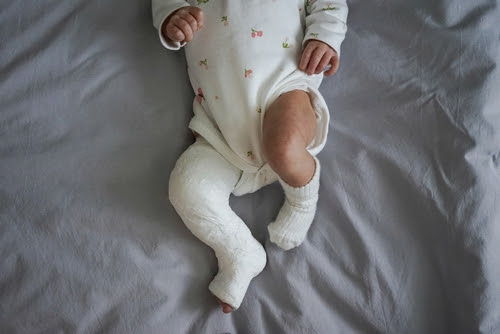Feet Issues from Childhood Still Haunting You? (Casts, Braces, Shoes?) 👟
The theme for this week …
What happens with your bones directly affects the muscles. When bones are immobilized for healing, the muscles tend to go offline impacting your ability to be active.
This week we look at how the treatment for improperly formed feet may be haunting you years later. Read on …
Foot corrected with a cast, or special shoes as a baby? Now you have hip, knee, or low back pain?
The tiny little cast from a childhood foot correction is a cute keepsake from an intervention at a worrisome point in time. Foot deformities are not rare — 1 in every 1000 births (.001%) — which equates to about 3600 babies per year in the US.
There are more boys affected and about half of the cases affect just a single foot, not both. Here is a nice description of foot deformities from the Boston Children’s Hospital.
Treatment is generally non-invasive and typically involves reshaping the feet via casts, braces or special shoes. As the foot morphs to ‘normal’, the baby can crawl and walk. Success!
But …
How can treatment affect muscle function development?
Although noninvasive, the treatments to reconfigure a developing foot can impact muscle development. How?
First, realize that the muscles are not working with proper coordination to begin with. This is because the structural alignment is skewed from first trimester development.
Second, the immobilization used to guide bone growth also prevents the adjacent muscles from learning to work properly. These tiny foot, ankle, and calf muscles are responsible for the smooth coordination of the foot with the ankle, knee, hip, and lower back.
As a teen or adult, the missed development causes stress and pain!
We find that the mismatch of bone and muscle function described above results in stress at the hip and low back. This often manifests as deep, unexplained pain in adulthood.
(We had to add a line on our intake form after finding this was such a common phenomenon in adult clients at the Bridging® Institute.)
Two reasons foot immobilization as an infant creates issues as we age
When your foot is immobilized at a young age, not only are the muscles shutdown in the process, but the following also happens:
- Missed Development: Essential developmental skills between the foot/knee/hip miss their chance to evolve, especially from tummy time! The missed micromovements result in tightness, which puts stress on joints and creates pain with specific movements.
- Structural Compensations: The weight of a cast pulls the pelvis off-center for enough time that the tension of low back muscles becomes unbalanced. Unaddressed, this tension difference remains through the adult years causing gait issues, and low back pain.
The good news is that these all change with the Bridging® Technique. Bridging® rebuilds the structural relationships within the foot and leg which enables strength, balance, and flexibility.
You can once again move with ease and confidence!
Insight of the week from Cara
Sue, now 58, recalls having ‘special shoes’ until first grade. That is her recollection of there being an issue with her feet as a young child. Photos confirmed the stories she’d been told — there were no cute sandals or gym shoes to be seen.
I met Sue because of her chronic low back pain and possible need for hip replacements. She had tried it all — physical therapy exercises, massage, chiropractic, acupuncture, and more. Nothing really seemed to make a dent. Not even the cortisone shots. She still had hope for an answer.
How did the shoes relate to her pain?
As part of the Bridging® process, we assess foundational movement relationships between the core and limbs. What did we find?
- Tight muscles! For Sue, these were so tight it felt almost like someone had scrolled her legs inward to tighten her hips. The hip stress tightened her lower back causing the unexplained tightness and back pain.
- Rigid knee and hip transitions. Functional transitions we all should develop in tummy time never had a chance to learn to work. These are rotational flows from foot up to the hip, especially used in squatting.
How did Bridging® help Sue?
We were able to guide the impacted muscles and reset those involved. This was done by understanding and recreating the developmental relationships she likely missed before 6 years of age.
As Sue’s hips began to unwind, she relaxed. Her breath had been held hostage too! By the way, most of the change played out in just a few sessions over a few months.
Sue still has Bridging® sessions, but with new goals. Now that her pain and mobility have improved, she is enjoying new activities and sports. With each new activity there is a new foot motion to fine-tune.
It’s so much fun to see her enjoying being active!

